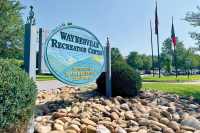The wheels through time roll on: WNC motorcycle museum celebrates 20 years, looks ahead
With a quick roll start to crank over the engine of the 1916 Traub motorcycle, Matt Walksler hops off the bike and knocks down the kickstand. The 106-year-old machine rumbles, the smell of oil and gasoline soon permeating the air. He turns to the crowd of a couple dozen folks making a semi-circle around him.
Wheels Through Time founder dies of cancer
Dale Walksler, the founder and curator of the Wheels Through Time Museum in Maggie Valley, passed away peacefully, with his wife by his side, at home on Feb. 3, after a courageous four-year battle with cancer.
Showcasing the history of the open road
 A loud roar echoed from the back of the building. The deafening sound is terrifying, yet exhilarating, with the smell of burning oil and gasoline permeating through the air.
A loud roar echoed from the back of the building. The deafening sound is terrifying, yet exhilarating, with the smell of burning oil and gasoline permeating through the air.
Bringing history back to the open road
 A loud roar echoed from the back of the building. The deafening sound is terrifying, yet captivating, heightened by the smell of oil and gasoline. A cloud of smoke wafted through the air, evoking the power and intrigue of a mechanical performance about to unfold.
A loud roar echoed from the back of the building. The deafening sound is terrifying, yet captivating, heightened by the smell of oil and gasoline. A cloud of smoke wafted through the air, evoking the power and intrigue of a mechanical performance about to unfold.
“It’s more than the sound,” Dale Walksler said, straddling a 1928 Harley-Davidson Hillclimber. “It’s also the sight, smell and taste. Starting this motorcycle up achieves all of your sensitivities.”
Maggie erupts with showdown between bar and museum
A formerly notorious bar will reopen in Maggie Valley despite bombastic protests from the owner of Wheels Through Time Museum, who fears it will attract the same seedy crowd and societal ills as the past establishment.
Dale Walksler commanded a freewheeling four-hour town meeting this week marked by sparring and insults, often evoking gasps and murmurs from the audience. It was far from the typically tame public hearing where a round robin of speakers takes short and civil turns at the microphone.
Instead, the hearing was akin to a television courtroom drama. Speakers could endlessly cross-examine each other with no time limits and little restraint on appropriate subject matter.
At issue was whether the town board would grant a permit to Robert Leatherwood to reopen the old Spring House bar. Walksler made a vigorous appeal to town leaders to deny the permit. He said that under past ownership, bar patrons spilled over onto his museum property, littering his parking lot with used condoms and drug needles. Walksler suspects the same crowds will return.
During his cross examination, the short and spry Walksler hovered inches away from the podium where the comparatively large Leatherwood stood. Leatherwood occasionally leaned into the podium in response to Walksler’s heated antics, bringing the two mere feet apart at times.
“Don’t push me,” Leatherwood told Walksler once.
Walksler routinely cut Leatherwood off if he didn’t like what he was saying, waving his hand to silence Leatherwood while tossing out statements ranging from “I’ve heard enough” or “Yeah, whatever,” or “I’ve made my point.”
One heated exchange followed a complaint by Walksler that riff-raff from the bar took up nightly residence in his parking lot. Both Walksler and his son live on museum property, and say they were often kept up all night by illegal partying that migrated onto their property from next door.
“Do you know where the closest residence is to your establishment?” Walksler asked.
“I have no idea Mr. Walksler. Why don’t you advise me on that,” Leatherwood said.
“We’ll talk later,” Walkser said, wheeling away from the podium.
“Anytime pal,” said Leatherwood.
Leatherwood then offered Walksler a free lifetime membership to the nightclub, and welcomed Walksler to come pass out coupons to his museum to bar patrons.
When aldermen or the town’s attorney tried to rein Walksler in, he wouldn’t hear of it.
“I don’t like to be interrupted,” Walkser barked at Mayor Roger McElroy at one point.
During one of Walksler’s cross-examinations, town attorney Chuck Dickson told him to stick to questioning the witness and save his own viewpoints for his own testimony.
“I think this is the appropriate time,” Walksler said and continued doing what he was doing.
Alderman Danya Vanhook, an ex-judge, ended up being the de facto handler of Walksler when he got out of line. Stepping back into her judge’s shoes, she objected when he delved into hearsay, and made him rephrase what she dubbed “compound questions.” She frequently called Walksler out of order for badgering witnesses.
“No arguing with each other. You have to let him answer the question,” Vanhook told Walksler. She even intervened when he mischaracterized the testimony of other witnesses.
Walksler said he feared the bar would lower the property values of his museum, which has a value of $20 million. Walksler’s museum is indeed world-class. It is internationally renowned for its unrivalled collection of historic bikes and memorabilia. Its iconic status is a fact he reminded the audience of often.
“I am a very successful person who has made an accomplishment in this town that none of you people could even dream of,” Walksler told the room.
Walksler belittled Leatherwood for striving to open such a bar.
“We all have to have goals I guess. I know I did when I was a kid and I pretty much achieved my goal, which is to open the coolest place in the world,” Walksler said.
Walksler often uses his museum as a platform to bash the rest of the town to visiting patrons. Shirley Pinto, who waits tables at Joey’s Pancake House, called him on this during the hearing. She said customers at the restaurant would divulge what Walksler had said about the rest of town while they were visiting the museum.
Jim Davis, a Maggie resident who came to the meeting to see the show, recounted a similar experience in the hallway after the meeting. A year ago, he took an out-of-town guest to the museum and they got an earful from Walksler, who ranted about town politics and criticized its people.
“As a person who just paid a ticket and walked in the door, he laid it all out,” said Davis.
Walksler has threatened to leave town with his museum if the town board granted the bar its permit, and questioned whether the town could afford to sacrifice its last standing tourist attraction with so many others now shuttered.
It won’t be the first time he has threatened to leave. He has vocally announced his intentions to pull out of the town on and off for a few years, but each time decided to stay.
Nonetheless, it is enough to strike fear into the hearts of motel owners who have little else besides motorcycle traffic driving business.
“A lot of people come see his museum,” Gabi Edwards, owner of a Holiday Motel, said in an interview. “It is very important, very important. Everybody comes away impressed not only with the museum but with Dale. I can’t imagine what else are we going to lose.”
Brenda O’Keefe, a longtime Maggie business owner, told Walksler his message would be more effective if he didn’t insult and attack people along the way. For example, when Walkser was questioning traffic flow in the bar’s parking lot, he said the design drawn by a local surveyor looks like it was done by three-year-old.
“I understand my personality flaw,” Walksler responded. “People have said before, ‘Oh Dale is his own worst enemy.’ I am not buying that.”
The real issue
While upstaged by the dueling personalities of Walksler and Leatherwood, the real issue was whether town leaders would endorse a bar that might devolve into a public nuisance.
Walksler said the bar has been “drug and alcohol” infested for two decades and called it a “total violation that everything that we as Americans believe in.” Police responded to calls at the Spring House 300 times over an eight-year period, he said, introducing the police reports as evidence.
Walksler held up photos of the sign still posted on the door of the bar from its last owner.
“No drugs, no pushers, no paraphernalia. No muscle shirts or wife beater shirts worn at any time. No biker gangs or colors to be worn. No knives, no guns, no brass knuckles,” Walksler read. “This is not the clientele we need in this town. This is not the establishment we need in this town.”
Walksler said the town’s reputation will be harmed at a time it can little afford to lose any more tourism business.
“As we know this town has 68 empty businesses between Dellwood and the hill. It’s not the gas and it is not the economy. It is decision making in this city hall that is substandard and has made this the town of broken dreams.”
Leatherwood said he would take measures to ensure the safety of bar patrons and neighbors. The bar will have metal detectors at the entrance, closed-circuit night vision cameras both inside and out, and hire off-duty cops to work the door.
“You are not going to have to fight your way in and fight your way out like it used to be,” Leatherwood said.
The metal detectors and bouncers didn’t appease Walksler. Instead, he took it as proof positive that the joint would cater to the underworld. Leatherwood said it was just a precaution, however.
“When people get drunk sometimes they get rowdy, sometimes they don’t. Men or ladies, they can both get rowdy,” Leatherwood said.
The Spring House changed hands several years ago, sold by longtime owner Ivy Suggs and converted into Big Michael’s, and then Little Rick’s. They lasted only a short time before the new owners lost the bar in a bank foreclosure. The building is now owned by Blue Ridge Savings Bank, which is leasing it to Leatherwood.
Leatherwood will name the bar Stingrays. It will technically be a private club requiring membership. By doing so, Leatherwood avoids a state law that requires establishments serving alcohol to also serve food.
Leatherwood previously had a long-haul trucking company, but it went bankrupt.
Breathing life into the Museum that Runs
A few steps past the door at Maggie Valley’s Wheels Through Time museum, and the characteristic, unmistakable scent of a mechanic’s workshop wafts out – a heady mix of grease, motor oil, gasoline and rubber worn down by open roads.
With the vast and impressive array of motorcycles and memorabilia on display in the museum — both ancient and modern, rusted and restored — it would be easy to think that it is the perfume of these dormant machines’ pasts, reminders of their greatness in battle, their glory on the track.
But meeting Dale Walksler, the museum’s proprietor, curator and greatest fan, will prove otherwise. To him, this is a living museum. It is hard to walk more than a few yards with him before he stops to crank up one bike or another and tell its story, and he knows them all. To Walksler, the stories seem to be almost as valuable as the motorcycles themselves.
“It’s all about the story and the history,” he says. “I don’t go out and chase any old motorcycle. It has to have a story.”
And all of them do. Walking through the museum, which stretches over two floors and features special exhibits, vintage racers, military motorcycles, stunt bikes, a plethora of other machines and the accessories and memorabilia that accompany them, Walksler points out one of his newest acquisitions: a strange, 1916 Harley Davidson contraption that is driven from the sidecar.
“I’ve found nothing about it,” he says enthusiastically, but he’s already got a trip planned to the Harley archives in Milwaukee to see what he can dig up. That, he says, is one of the key features of what he does.
“Research, lots of research,” is how he says he’s gotten to know the life stories of the bikes that call the museum home, and some are the most storied motorcycles this country has produced. The knowledge that is the prize for all that research, Walksler shares freely with anyone who happens to be around. A museum patron passes, asking about a particular bike in the back corner of the museum, and Walksler’s face is alight.
“That particular motorcycle was ridden by the Jack Pine champion,” he begins, before regaling the man and his wife with the story of the bike’s win and its rider’s own history, before quickly rattling off the answers to a few more obscure questions about the history of Harley Davidson shifting.
A tale behind each bike
Walksler is a compact man, his tawny hair and goatee shot through with grey, who walks with purpose and talks with animation, especially when the subject is motorcycles. His knowledge is encyclopedic, though not dry, and he has the delivery of a practiced showman — a mix of enthusiasm and bravado, information and entertainment.
Passing by another couple in motorcycle gear, he stops mid-sentence to thank them for stopping by. They’re from New Hampshire, and they’re riding their way back home.
“Would you like to see the rarest motorcycle in the world?” he asks slyly, and the New Hampshirans, of course, oblige. Leading the way, he begins telling the story of the Traub, a mysterious, one-of-a-kind motorcycle about which very little is known, apart from the fact that it was found in a brick wall by a Chicago fireman in 1967.
Walksler stops next to an old, reddish-orange bike with ‘Traub’ emblazoned on the side in stylized script and entertains his audience with the tale of how he acquired the bike from fellow collector Richard Morris. Before that, he says, it passed through the hands of both Steve McQueen and his stuntman, Bud Ekins, also an aficionado.
“Would you like to see it run?” he asks, almost rhetorically, and as he cranks the ancient machine, even more visitors materialize, drawn by the shuddering, spitting, deep-bass call of the Traub that bounces and echoes, ear-splittingly amplified, off the high warehouse ceilings. The audience is growing.
The Traub is clearly one of the crown jewels in Walksler’s collection. Some people, he says proudly, come just to see it. And whether or not this is true, his excitement makes it believable, and even a cursory inquiry will reveal that it is, in fact, a remarkably rare piece of antiquity.
But as he leads the impromptu tour group around the floor, his manner is surprisingly low on favoritism. The consummate collector, he is enamored of his entire compendium equally, and he’s been adding to it for most of his life.
“The first bike I ever owned was a 1957 Harley,” he says. “It was $25.” When he bought a bike off another high schooler for roughly the same price, and promptly sold one of its parts for $125, he was sold.
A shop followed in 1970, and a Harley dealership in southern Illinois sprung up a few years later. Along the way, Walksler was meticulously building his collection, anticipating the day he would share it with the public at large.
“Being selective is really important,” he says. He judges his acquisitions by three criteria: its rareness and desirability, make — he collects only American machines – and the story behind the piece.
“And then I’ve still got to make it run,” he says, grinning as he perches reading glasses atop his head and sets down a stack of photos sent to him by one of many hopeful sellers. And indeed, most of the museum’s specimens do at least crank, even the most geriatric and unlikely candidates.
In fact, he just completed the inaugural Motorcycle Cannonball — a jaunt across the nation raced exclusively on bikes that are more than 95 years old — on a 1915 Harley Davidson from the collection.
Unrivaled passion
Wheels Through Time, in its first incarnation, began in 1993 in Mount Vernon, Illinois, where it enjoyed a 13-year run before Walksler packed it in and shipped off to Maggie Valley, where he set up shop because, as he points out, it’s where the motorcyclists already come.
“It’s a known dot on the map,” he says, launching into an anecdote to illustrate the point.
“My brother was in a meeting, and he says, ‘my little brother is moving to Maggie Valley,’ and three people — this is in Chicago — said, ‘Hey, I know where that is!’”
Since his arrival in 2006, Walksler hasn’t exactly enjoyed an untarnished relationship with the community. Frustration with what Walksler perceives as a lack of reverence for his museum by locals even prompted him to consider another move last year.
But back on the floor, he has only words and eyes for the collection that has sent him into relative prominence in the motorcycle community.
A member of the little group — an elderly man in a denim shirt, jeans held up with black suspenders, worn riding boots an a red cap that identifies him as the St. Louis Bevo Beer Packaging Supervisor — pipes up to ask if there are any flat-track bikes. His name is Ed Gahn, and he is a 71-year-old flat-track racing veteran himself.
“I got to see hospitals all over the Midwest,” he quips, laughing as he folds his arms across his chest.
Of course, replies Walksler. He quickly drums up three or four names that Gahn recognizes, and when a particularly legendary and difficult bike — Leaping Lena — is mentioned, Walksler bids the group to follow him, for that same bike, he says, is in the back corner, and both men have ridden it.
And so went the morning — a spontaneous show featuring his most treasured highlights and history of American motorcycle culture, with Walksler acting as emcee, ringmaster and professor. He summons a battery of dates and figures, names and stories, developments and disasters with keen alacrity, in his element among his beloved machines, exuding charisma as he coaxes half a dozen motorcycles to life for the benefit of his elated spectators.
But not everyone is as pleased with Walksler, or his efforts locally. The enmity between him and some in the local community is no secret, and he isn’t timid about sharing his disdain for what he perceives as a less-than-welcoming reception he and his museum have garnered from some tourism and business leaders.
“I’m not the kind of person who’s going to change my focus and life for the people who don’t get it,” he says, adding that he feels no support from the local tourism entities or local government. “I honestly think a lot of them think ‘I guess we already get enough of them [motorcyclists] through here, so that’ll do.’”
When asked why he chose to keep the museum in Maggie Valley despite conflicts within the community, he answered that “the real reason is that I’ve made as many adjustments as I’m willing to make.”
As far as an end to the hostility is concerned, Walksler says he is open to better relationships locally, but seems less inclined to proactive cultivation.
“My door is open all the time,” he says.
But despite his personal quarrels on the local scene, his offerings to those inside and out of the motorcycle community are a unique, well-curated collection that reflects the passion and eagerness of its owner.
“This isn’t a motorcycle museum,” he says, “it’s a museum of American history and culture.”









